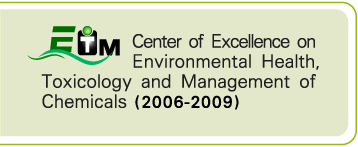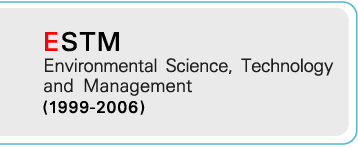|
Arsenic is widely contaminated in environment. Epidemiological studies demonstrated that chronic exposure of arsenic leads to cancers in multiple organs including skin, lungs, and bladder. However, underlined mechanisms of arsenic carcinogenesis remain elusive. Arsenic has been shown to cause increase in cell proliferation which can potentially initiate or promote cancer formation. Extracellular regulated kinase (ERK) is a signaling molecule that plays important role in growth promotion. Its activation is associated with activation of variety of tyrosine kinase growth receptors including vascular growth factor receptor (VEGFR) and epidermal growth factor receptor (EGFR). Interestingly, arsenic has been reported to increase VEGF expression, and EGFR activation which may be contribute to arsenic-induced cell proliferation. Therefore, this research project investigated that induction VEGF hence activation of VEGF mediated signaling, and activation of EGFR and its signaling pathway were involved in arsenic-induced cell proliferation. In the present study, we demonstrated that low dose of arsenite induced cell proliferation in human neuroblastoma SH-SY5Y cells as evidence by increases in cell viability and BrdU incorporation. Additionally, arsenite treatment increased VEGF expression and secretion. Inhibition of VEGF signaling by inhibitor of VEGF receptor 2 kinase, SU4312, and anti-VEGF antibody blocked arsenite-induced BrdU cell proliferation. These results indicated that arsenite induces cell proliferation through its induction of VEGF production in SH-SY5Y cells. Moreover, arsenite caused activation of ERK, a key signaling molecule involves in cell growth, and this activation was attenuated by SU4312 suggesting contribution of VEGF-mediated ERK activation in arsenite-induced cell proliferation. The involvement of EGFR in arsenic-induced cell proliferation was investigated using lung adenocarcinoma A549 cells which express high level of EGFR. The results reveal that arsenite (100 M) caused a significant increase in EGFR tyrosine phosphorylation suggesting arsenite treatment activated EGFR in A549 cells. Interestingly, the increment of EGFR tyrosine phosphorylation was only partially blocked by AG1478 (selective inhibitor of EGFR kinase) suggesting that EGFR kinase was partly responsible for arsenite-induced EGFR tyrosine phosphorylation. While co-treatment of arsenite and N-acetylcysteine (NAC) which is a well-known antioxidant, brought EGFR tyrosine phosphorylation down to level comparable to control. This result suggested the involvement of oxidative stress in arsenite-induced EGFR tyrosine phosphorylation. Moreover, arsenite induced ERK activation in A549 cells, and this activation was abolished by NAC co-treatment indicating that arsenite-induced oxidative stress was involved in activation of ERK. แหล่งข้อมูล:
|
 Center of Excellence on Environmental Health and Toxicology (EHT)
Center of Excellence on Environmental Health and Toxicology (EHT)










